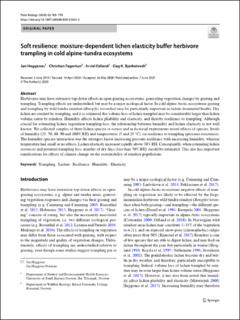| dc.contributor.author | Heggenes, Jan | |
| dc.contributor.author | Fagertun, Christian | |
| dc.contributor.author | Odland, Arvid | |
| dc.contributor.author | Bjerketvedt, Dag K. | |
| dc.date.accessioned | 2021-05-11T12:31:47Z | |
| dc.date.available | 2021-05-11T12:31:47Z | |
| dc.date.created | 2020-09-21T10:12:08Z | |
| dc.date.issued | 2020 | |
| dc.identifier.citation | Heggenes, J., Fagertun, C., Odland, A., & Bjerketvedt, D. K. (2020). Soft resilience: moisture-dependent lichen elasticity buffer herbivore trampling in cold alpine-tundra ecosystems. Polar Biology, 43(7). | en_US |
| dc.identifier.issn | 0722-4060 | |
| dc.identifier.uri | https://hdl.handle.net/11250/2754940 | |
| dc.description.abstract | Herbivores may have extensive top-down effects in open grazing ecosystems, generating vegetation changes by grazing and trampling. Trampling effects are understudied, but may be a major ecological factor. In cold alpine-Arctic ecosystems grazing and trampling by wild tundra reindeer (Rangifer tarandus) may be particularly important in lichen-dominated heaths. Dry lichen are crushed by trampling, and it is estimated that volume loss of lichen trampled may be considerably larger than lichen volume eaten by reindeer. Humidity affects lichen pliability and elasticity, and thereby resilience to trampling. Although crucial for estimating lichen vegetation trampling loss, the relationship between humidity and lichen elasticity is not well known. We collected samples of three lichen species in natura and in factorial experiments tested effects of species, levels of humidity (25, 70, 80, 90 and 100% RH) and temperatures (5 and 25 °C), on resilience to trampling (pressure resistance). The humidity:species interaction was the strongest factor increasing pressure resilience with increasing humidity, whereas temperature had small or no effects. Lichen elasticity increased rapidly above 70% RH. Consequently, when estimating lichen resources and potential trampling loss, number of dry days (less than 70% RH) should be estimated. This also has important ramifications for effects of climate change on the sustainability of reindeer populations. | en_US |
| dc.language.iso | eng | en_US |
| dc.rights | Navngivelse 4.0 Internasjonal | * |
| dc.rights.uri | http://creativecommons.org/licenses/by/4.0/deed.no | * |
| dc.title | Soft resilience: moisture-dependent lichen elasticity buffer herbivore trampling in cold alpine-tundra ecosystems | en_US |
| dc.type | Peer reviewed | en_US |
| dc.type | Journal article | en_US |
| dc.description.version | publishedVersion | en_US |
| dc.rights.holder | © The Author(s) 2020. | en_US |
| dc.source.volume | 43 | en_US |
| dc.source.journal | Polar Biology | en_US |
| dc.source.issue | 7 | en_US |
| dc.identifier.doi | https://doi.org/10.1007/s00300-020-02685-4 | |
| dc.identifier.cristin | 1831529 | |
| cristin.ispublished | true | |
| cristin.fulltext | original | |
| cristin.qualitycode | 1 | |

